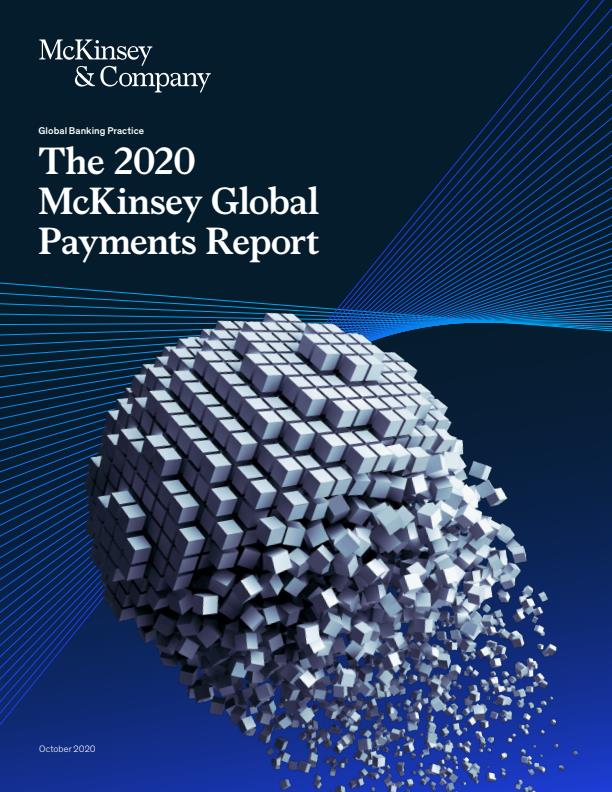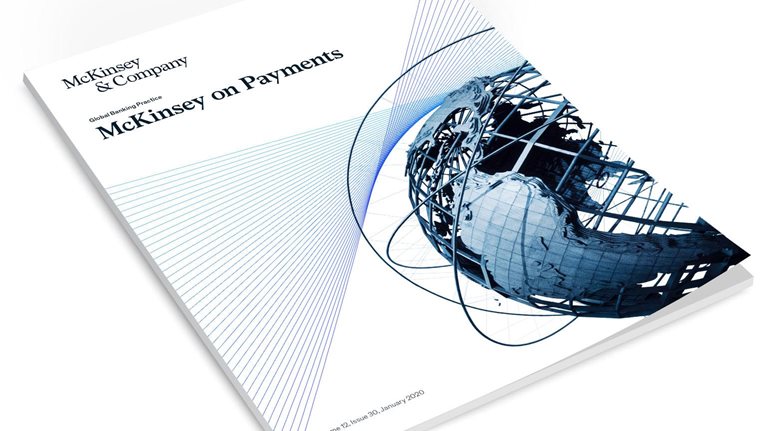For the global payments sector, the events of 2020 have reset expectations and significantly accelerated several existing trends. The COVID-19 public- health crisis and its many repercussions—among them, government measures to protect citizens and rapid changes in consumer behavior—changed the operating environment for businesses, large and small, around the world. For the payments sector, global revenues declined by an estimated 22 percent in the first six months of the year compared with the same period in 2019. We expect revenues to recover (only to a degree) in the second half of 2020, ending 7 percent lower than full-year 2019. Over the past several years, payments revenues had grown by roughly 7 percent annually, which means this crisis leaves revenues 11 to 13 percent below our prepandemic revenue projection for 2020.
Given the impact of the COVID-19 crisis on the operating environment, we are diverging from our usual approach of delivering perspectives on the current year’s global payments landscape relative to the prior year. Instead, we focus primarily on the state of the payments ecosystem in 2020 and explore the actions payments providers need to take to compete effectively in the “next normal.”
The insights provided in the full report are informed by McKinsey’s proprietary Global Payments Map, which has provided a granular, data-based view of the industry landscape for more than 20 years.
A half decade of change in a few months
For global payments, 2020 stands in dramatic contrast to the year before, which was a relatively stable year. Global revenues grew at nearly 5 percent in 2019, bringing total global payments revenue to just under $2 trillion (Exhibit 1). Payments also continued to grow faster than overall banking revenues, increasing its share to just under 40 percent, compared with roughly one-third only five years earlier.

Any stability was quickly disrupted in early 2020 by changing geopolitics coupled with reactions to the COVID-19 pandemic, both public (physical-distancing measures and limits on business activity) and private (anticipatory and causal shifts in consumer and commercial behaviors). As a result of the public-health crisis, payments revenues in the first six months of 2020 contracted by an estimated 22 percent (roughly $220 billion) relative to the first six months of 2019. We expect full-year 2020 global payments revenue to be roughly $140 billion lower than in 2019—a decline of about 7 percent from 2019—a change equal in size to prior years’ annual gains, which leaves revenues 11 to 13 percent below our prepandemic revenue projection for 2020.
What we already know
Once the classification of COVID-19 moved from a local outbreak to a global pandemic, many governments moved to protect their citizens, leading to lockdowns with various degrees of limitation. The immediate consequence was, of course, a steep reduction in discretionary spending and a severe demand-side shock, along with reductions in cash usage. Discretionary spending initially sank by 40 percent globally. The impact was especially great in the travel and entertainment category, which was off 80 to 90 percent. While some categories of spending rebounded, consumers’ well-documented shift from the point of sale (POS) to digital commerce accounts for the reduced use of cash.
Overall, in retail, the impact was not a decline but a shift in buying behavior. In the first six months of the year, consumers spent $347 billion online with US retailers, up 30 percent from the same period in 2019—corresponding to six times the annualized 2019 growth rate of online retail.1 Amazon’s second-quarter 2020 numbers recorded 40 percent year-over-year growth, boosted in particular by the tripling of grocery sales. In Europe, differences in shopping behavior among geographies were strongly reduced and differences among age groups eroded as many consumers (in particular, older shoppers) turned to online shopping for the first time.
Consequently, all forms of electronic peer-to-peer and consumer-to-business payments have been boosted. In many regions, this has mostly benefited debit cards, which typically align with lower-value transactions and are a logical cash substitute for contact-averse consumers. Switzerland reported an increase in share of debit-card spending to 72 percent, from 65 percent, between January and May 2020,2 mostly at the expense of cash. Higher limits for contactless payments also triggered rising adoption rates across the globe, making inroads beyond debit’s typical domain of smaller-value transactions. For credit cards, the picture is more nuanced; consumers in certain geographies seem to be paying off credit-card balances in preparation for challenging times ahead. In Australia, for example, credit-card share among total card spending fell by five percentage points between February and June 2020, in favor of debit cards.3 In Asia, however, alternative payments, such as instant and mobile payments, grew, while credit cards retained their strong incumbent position supporting e-commerce and POS transactions.
Logically, given the steep reduction of in-person purchases, cash transactions and ATM usage declined—the latter after an initial wave of withdrawals by anxious consumers. Germany and the United States each saw spikes in cash withdrawals in the days leading up to lockdowns. The fear of contracting COVID-19 through high-traffic ATMs and, in some cases, the refusal of merchants to accept cash (often despite legal obligations) nudged consumers toward electronic payment options to complete purchases. ATM usage fell by 47 percent in April 2020 in India, while the United Kingdom experienced 46 percent declines in ATM usage per month on average from March to July 2020. By the end of 2020, we expect a shift of four to five percentage points in the share of global payment transactions executed via cash—down from 69 percent in 2019—propelled by evolving behavior in both mature and emerging markets (Exhibit 2). This is equivalent to four to five times the annual decrease in cash usage observed over the past few years. The reduced use of cash benefits banks overall: the cost of cash handling exceeds cash-related revenue inflows, and electronic payments generate incremental revenue.

The pandemic has accelerated the move from physical to virtual banking. Banks in multiple geographies are closing branches (or in some cases, will not reopen branches they closed as a result of the pandemic), as well as ATMs. In Australia, the top four banks have removed 2,150 ATM terminals and closed 175 bank branches since June.4
These accelerated behavior changes in response to the COVID-19 crisis caused a fundamental shift in adoption of technologies, such as real-time account-to-account payment infrastructures, that had been developed over recent years. Investments in instant payments have begun to reap greater benefits, both in POS and e-commerce usage of instant solutions. The trend comes in response to customer expectations for speed, price differences, and greater adoption of customer-facing applications, such as specialist GrabPay in Singapore or bank solution MobilePay in Denmark. In the United Kingdom, as payment speed becomes more important, consumers and businesses have increasingly opted to settle bills online. For example, the average daily value of transactions processed by the Faster Payments service rose by more than 10 percent from the fourth quarter of 2019 to the end of March 2020. In India, banks stepped up their digital propositions, integrating bill payment, e-commerce links, and Unified Payments Interface (UPI)—the nation’s local real-time payment system—into mobile banking apps to present three digital options in a single customer interface. UPI spending increased by roughly 70 percent over the first seven months of 2020.
At the same time, governments have tried to protect the economy as a whole and the well-being of companies as well as citizens. Additional easing of monetary policies led to lower interest rates, further deteriorating interest margins. Monetary authorities reduced benchmark rates in Europe and the United States and then in emerging markets, including Brazil, India, and South Africa, to limit the impact of pandemic-related recession, making net-interest-margin (NIM) compression a global phenomenon. Large and small markets alike are experiencing rate cuts of 100 to 300 basis points. Overall, we expect global interest margins to contract by approximately one-quarter percent, on average, in 2020, compared with a six-basis-point reduction in 2019, shrinking payments revenues globally by approximately $82 billion. Digitization benefits must first fill this gap before generating growth.
Cross-border payments flows also have been severely affected by the pandemic, as well as by geopolitical dynamics. In 2019, cross-border payments totaled $130 trillion, generating payments revenues of $224 billion (up 4 percent from the previous year). In the first half of 2020, many cross-border fundamentals radically changed:
- International travel all but ground to a halt, with more than 90 percent of countries imposing restrictions. Transaction-fee margins on remaining volume also declined, because of waivers offered to stimulate demand to offset the impact of a reduction in leisure and business travel flows, which fell by more than 70 percent.
- During the pandemic, interregional trade saw greater impact than intraregional. Drops in interregional flows for Asia (−13 percent), Europe (−20 percent), and the United States (−23 percent) directly cut into cross-border payments volumes, while the prices of oil and other commodities fell sharply.
- Business-to-consumer payouts (often salary disbursements) and remittance payments slowed, because of restrictions on the movement of cross-country workers and growing unemployment.
- Cross-border e-commerce volumes provided a notable exception to the gloomy news: the second quarter of 2020 brought double-digit growth as initial logistic challenges were resolved. UPS and PayPal, for example, reported double-digit growth on cross-border shipment volumes and the value of merchandise sold.
- Increased volatility and uncertainty have enabled growth in foreign-exchange-related revenues and pushed up treasury-related transactions as companies scramble to mobilize surplus cash.
In addition to the impacts of the COVID-19 crisis, certain geopolitical forces that began to materialize in 2019 have grown stronger since. Many companies are realizing the strategic weaknesses in their existing global supply chains, given trade frictions and potentially recurring public-health disruptions, leading to the exploration of nearshoring and other rebalancing. McKinsey analysis reveals potential shifts of as much as $4.6 trillion of global trade flows over the next five years. The value-chain shifts that began before the crisis have yet to take full effect—because of the complexity of moving such supply chains and the challenge of building new ones—so this is a longer-term trend.

How payments can adjust to the coronavirus pandemic—and help the world adapt
The rest of 2020 and beyond
The second half of 2020 presents a quite different outlook. Broadly, we see some pressures from the first half continuing but with pronounced geographic variations.
Our forecast uses McKinsey’s nine macroeconomic scenarios for the impact of the COVID-19 crisis. According to a survey of more than 2,000 executives around the world, the most likely outcome is the muted-recovery scenario (A1), a combination of virus recurrence and a muted economic recovery, with regional differences.
Applying the A1 scenario to global payments, we forecast that most categories of payment transactions are poised for sharp and rapid rebounds as lockdowns are lifted and behavioral shifts from cash to electronic payments are largely sustained. On the downside, interest-dependent revenue components are likely to remain suppressed for an extended period, mostly affecting banks that provide payment services. For specialists and fee-based revenues, much will depend on differences in spend patterns (for both businesses and consumers) before and after the crisis. For instance, dining, travel, and entertainment expenditures, which often carry higher transaction fees, are unlikely to rebound in the near term.
As we indicated, not all players, countries, and products will arrive at the same end state (see sidebar “A regional overview of the year in payments”). At a regional level, the following differences are notable:
- Asia–Pacific (excluding China) could suffer larger declines, as its revenue model is more affected by NIM contraction, faces increasing government pressures on mass-market transaction fees, and has greater exposure to long-term affected industries, such as travel, tourism, and international remittance payments.
- Europe may be poised for a swifter rebound, for two reasons. First, NIMs were already so compressed before the COVID-19 crisis that there was little room for further squeezing. Second, volume growth is being fueled by the acceleration of digital migration in Southern and Eastern Europe, and by government stimulus measures.
- In North America, the revenue benefit from an accelerated shift to digital channels has been more than offset by credit-card economics—outstanding balances are down roughly 29 percent from 2019 levels, and increased delinquencies are a possibility. Considering credit cards are the largest source of the region’s payments revenue, at roughly 44 percent, the decline in outstanding balances alone will outweigh the benefits of increased use of digital channels.
- In Latin America, which is characterized by a significant unbanked population, cash usage will likely remain resilient. Among the banked, Visa-supported mobile wallets such as PLIN and Yape have gained more than a million users since December 2019, with the pandemic accelerating this trend.
- Overall, the greatest recovery opportunities reside in countries with low electronic penetration (such as Brazil, India, Indonesia, and Thailand), as the next normal provides impetus for electronification. However, countries starting from a high level of digitization (such as France, Germany, and the United Kingdom) are also seeing pandemic-induced behavior push cash usage to the minimum—fueling payments-revenue growth.
Overall, while the global health crisis leaves banks and specialists with meaningful revenue concerns, the real challenge—as well as the real opportunity—lies in embracing the acceleration of change. If that issue is addressed properly, the global impact on payments could be significantly more positive than the outlook for GDP (see sidebar “The relationship between GDP and payments revenue”).
Looking forward: New rules for engagement
Long-term forecasting is unusually difficult in the current global environment, given the looming uncertainty on multiple fronts: economic recovery, interest rates, global trade, and a murky time frame for public-health breakthroughs. One thing seems clear, however. The imperative to accelerate transformations to digital-first and more agile organizations has never been greater, and it exists globally.
Still, the current global context removes many of the long-standing impediments to embracing transformation. As financial institutions enter this period of change, we propose five major themes to which payments and bank executives should be particularly attentive:
- Choose where you play wisely. The composition of your customer portfolio matters more than ever, as restructuring of consumer and commercial commerce reshapes where value is captured in payments. Growth is notably accelerating in the small and medium-size enterprise segment, B2B–to consumer (B2B2C) business models, and new customer arenas, such as cross-border e-commerce. The role of platforms is also growing fast, with ecosystems as a new growth segment. The shift to digital makes it possible for providers to create far more tailored solutions, and customers have shown a willingness to pay for these if sellers demonstrate value.
- Services and solutions, not financial products. Commercial customers expect bank and payments partners to enable greater sales by improving end-customer experience and the adoption of new business models—for instance, marketplace onboarding, B2B2C credit, and loyalty services—that do more than move money and manage cash flow. For consumers, the payment step is moving into the background of the shopping journey, and they expect support with conducting commerce and avoiding negative consequences, not merely a means to pay.
- Sales excellence. Transaction banking and acquiring are nearly a decade behind the technology and telecom sectors in sales and customer-management practices. These other industries have an entirely different skill set and language for sales and service—for example, sales motions, agile sales, inside sales, and customer success—all made possible by data and algorithms delivering the best adapted solutions for the market. Closing this decade-wide gap over the next two years will deliver significant value.
- Transaction-banking client experience. New challenges in supply chains and growing trade pressures are accelerating what has been a slow disruption in international payments and trade. Delivering the long-promised step-change improvement to corporate clients will require fundamental organizational change, particularly for siloed banks.
- Change in focus from the time value of money to the money value of time. Becoming digital by default requires significantly redefining the institution’s operations through the lens of customer journeys. To plan that digital transformation, most players have built road maps spanning the next five to six years. But given the modified revenue context, continued investment requirements, and market expectations spurred by the new environment, winners will find a way to deliver on this transformation within 18 to 24 months.
The events and trends of 2020 have undeniably created a changed global context for payments. What is most significant about this change is not so much the importance of the payments business or the kinds of trends transforming the market, but the speed at which the change is occurring. Change in 2020 takes place four or five times faster than before. This puts all actors on the payments landscape under pressure to transform and adapt in order to preserve their positions and results.
To download the full report or individual chapters, use the links below:
Full report
Chapter 1: The accelerating winds of change in global payments
Chapter 2: Merchant acquiring: The rise of merchant services
Chapter 3: Supply-chain finance: A case of convergent evolution?
Chapter 4: A burning platform: Revamping bank operating models for payments
Chapter 5: Closing the gap: Matching attackers on B2B sales for SMEs





